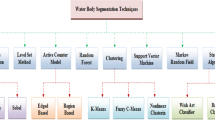Abstract
The water body segmentation is precious for assessing its role in ecosystem services with the circumstances of climate change and global warming. The accurate water body segmentation from Landsat imagery is great implication for water resource planning and socioeconomic development. Deep Neural Network has capability to extract the useful features of the water body of Landsat imagery and classify as water body and non-water body. In this paper, the water body segmentation is carried out by creating and training a deep learning network called SegNet which is derived from VGG16. Pixel Labeled Data of the input dataset are used for training the deep hidden units and the learned features are used to extract the water body in input test images. The Landsat images are used to implement the proposed and the existing methods. The performance measures such as accuracy, mean Boundary F1 Score (BF) score and IoU (Intersection Over Union) are used to compare the proposed method with the existing methods. The proposed method shows improved performance than the existing methods with the average accuracy of 96.7%. Also, the performance of the proposed method is examined with different number of iterations and different sets of training samples. The performance analysis results are good reference for application developers of deep neural network.

(Source: https://www.cs.toronto.edu/~frossard/post/vgg16/) [22]

(Source: Vijay Badrinarayanan [19])













Similar content being viewed by others
References
Anandkumar, Ramakrishnan, and Ramanujam Kalpana, (2019) Designing a fast image encryption scheme using fractal function and 3D Henon Map. Journal of Information Security and Applications, vol.49, pp.
Jupp, D.L.B,(1985) Landsat based interpretation of the cairns section of the great barrier reef marine park, natural resources series/Division of water and land resources, commonwealth scientific and industrial research organization.
Barton, I. J., & Bathols, J. M. (1989). Monitoring floods with AVHRR. Remote Sensing of Environment, 30(1), 89–94.
Ahmad, Anuar, Selamat, Ali, Rokni, Komeil, & Hazini, Sharifeh. (2014). Water feature extraction and change detection using Multitemporal landsat imagery. Remote Sensing. https://doi.org/10.3390/rs6054173
Lateef, F., & Ruichek, Y. (2019). Survey on semantic segmentation using deep learning techniques. Neurocomputing, 338, 321–348.
Braud, D.H and Feng,W, (1998) Semi-automated construction of the Louisiana coastline digital land/water boundary using Landsat thematic mapper satellite imagery Louisiana applied oil spill research and development program, OSRAPD Technical Report Series, 97(2).
Wang, J., Zhang, Y., & Kong, G. (2004). ’The application of multi-band spectral relationship method in water body extraction. Mine Surveying, 4, 30–32.
Xu, H. (2005). Fast information extraction of urban built-up land based on the analysis of spectral signature and normalized difference index. Geographical Research, 9(5), 589–595.
Gao, H., Xu, J., Wang, L., & Jing, L. (2016). An effective modified water extraction method for Landsat-8 OLI imagery of mountainous plateau regions. IOP Conf. Series: Earth and Environmental Science. https://doi.org/10.1088/1755-1315/34/1/012010
Mcfeeters, S. K. (1996). The use of the Normalized Difference Water Index (NDWI) in the delineation of open water features. Taylor & Francis - International Journal of Remote Sensing, 17(7), 1425–1432.
Jiang, Hao, Huang, Jianxi, Feng, Min, Ning, Lu., Xiao, Tong, & Zhu, Yunqiang. (2014). An automated method for extracting rivers and lakes from Landsat imagery. Remote Sensing. https://doi.org/10.3390/rs6065067
Ronneberger, O., Fischer, P., & Brox, T. (2015). U-Net: Convolutional networks for biomedical image segmentation, MICCAI 2015. Part III, LNCS, 9351, 234–241.
Chhor, G., & Aramburu, C.B. (2017), Satellite image segmentation for building detection using U-net.
Mohammad Yousuf Saifi, Jimmy Singla, Nikita, (2020) Deep learning based framework for semantic segmentation of satellite images', proceedings of the fourth international conference on computing methodologies and communication, IEEE Xplore Part Number:CFP20K25-ART; ISBN:978–1–7281–4889–2.
Xiaoyang, Xie, Bo, Li., & Xingxing, Wei. (2020). Ship detection in multispectral satellite images under complex environment. Journal of Remote Sensing, 12(792), 1–19.
Mishra, N. K., Kumar, A., & Choudhury, K. (2021). Deep convolutional neural network based ship images classification. Defence Science Journal, 71(2), 200–208. https://doi.org/10.14429/dsj.71.16236
Alqazzaz, S., Sun, X., Yang, X., & Nokes, L. (2019). ’Automated brain tumor segmentation on multi-modal MR image using SegNet. Computational Visual Media. https://doi.org/10.1007/s41095-019-0139-y
Panboonyuen, T., Jitkajornwanich, K., Lawawirojwong, S., Srestasathiern, P., & Vateeku, P. (2017). ’Road segmentation of remotely-sensed images using deep convolutional neural networks with landscape metrics and conditional random fields. Remote Sens., 9(7), 680.
Badrinarayanan, V., Kendall, A., & Cipolla, R. (2016). SegNet: A deep convolutional encoder-decoder architecture for scene segmentation. IEEE Transactions on Pattern Analysis and Machine Intelligence. https://doi.org/10.1109/TPAMI.2016.2644615
Shervin Minaee, Yuri Boykov, Fatih Porikli, Antonio Plaza, Nasser Kehtarnavaz, and Demetri Terzopoulos,(2020), ' Image segmentation using deep learning: A Survey', arXiv:2001.05566v2 [cs.CV], pp.1–23.
Long, J, Shelhamer, E and Darrell,T, (2015) Fully convolutional networks for semantic segmentation', in Proceedings of the IEEE conference on computer vision and pattern recognition, pp. 3431–3440.
Davi Frossard, (2016, June 17), Architecture of VGG16, from https://www.cs.toronto.edu/~frossard/post/vgg16/
Author information
Authors and Affiliations
Corresponding author
Additional information
Publisher's Note
Springer Nature remains neutral with regard to jurisdictional claims in published maps and institutional affiliations.
Rights and permissions
About this article
Cite this article
Thayammal, S., Jayaraghavi, R., Priyadarsini, S. et al. Analysis of Water Body Segmentation from Landsat Imagery using Deep Neural Network. Wireless Pers Commun 123, 1265–1282 (2022). https://doi.org/10.1007/s11277-021-09178-5
Accepted:
Published:
Issue Date:
DOI: https://doi.org/10.1007/s11277-021-09178-5




